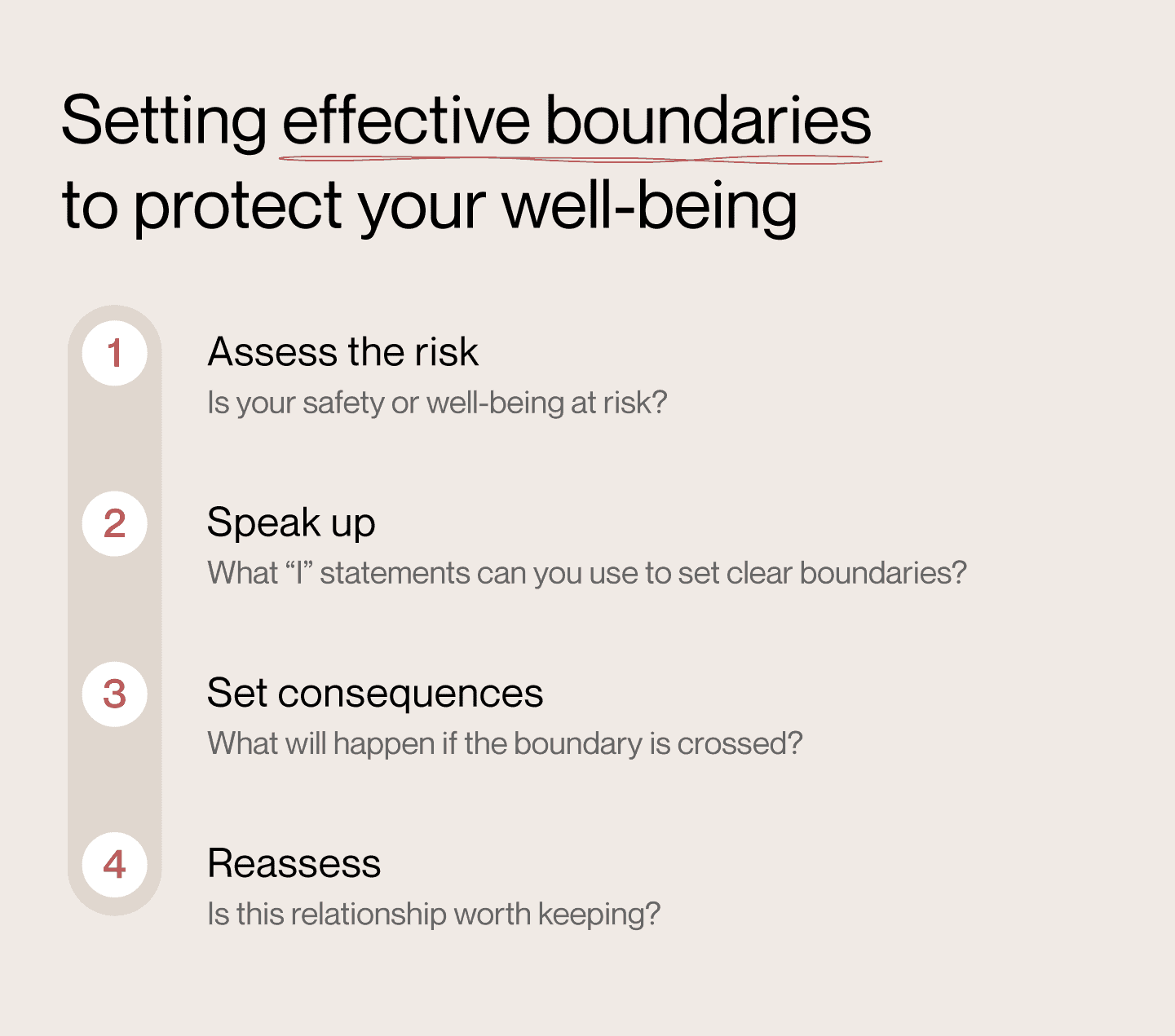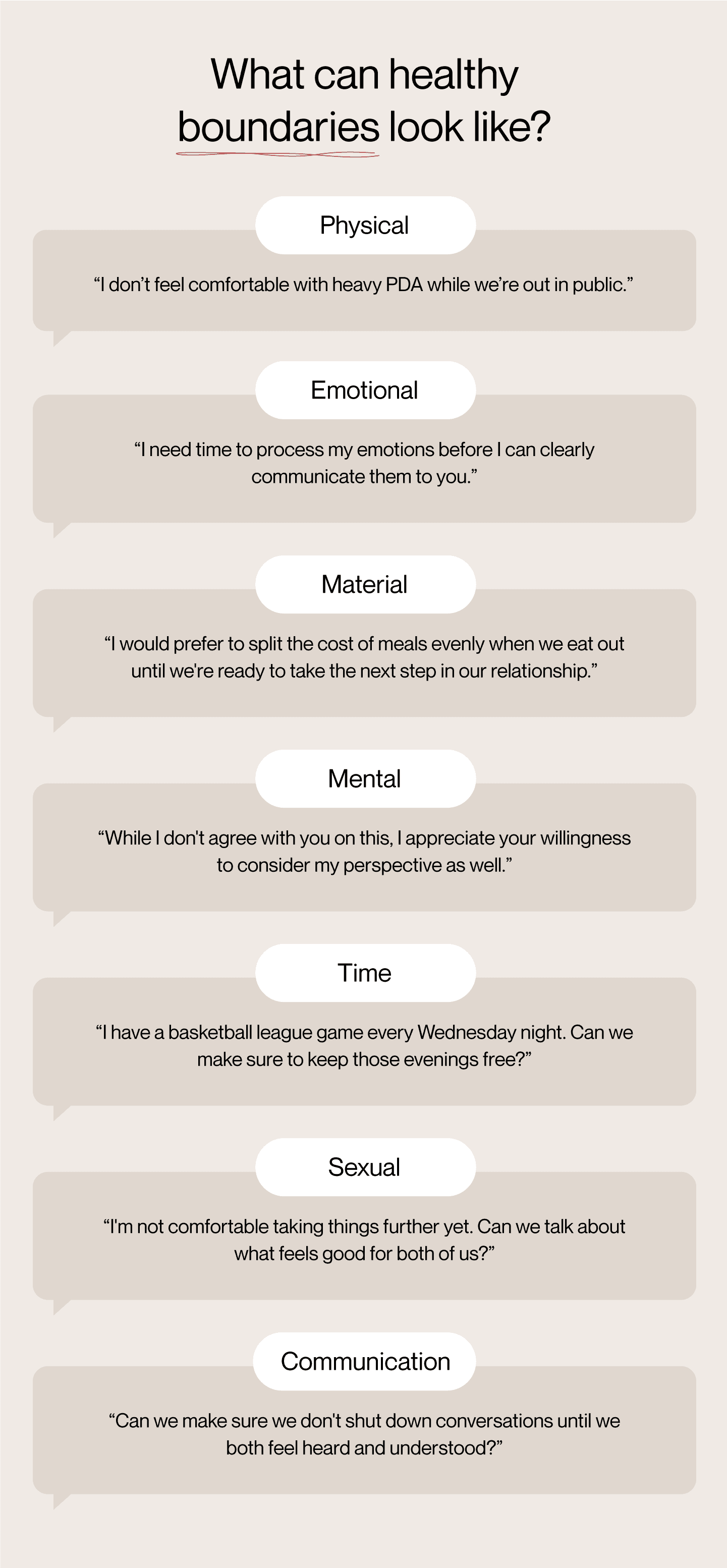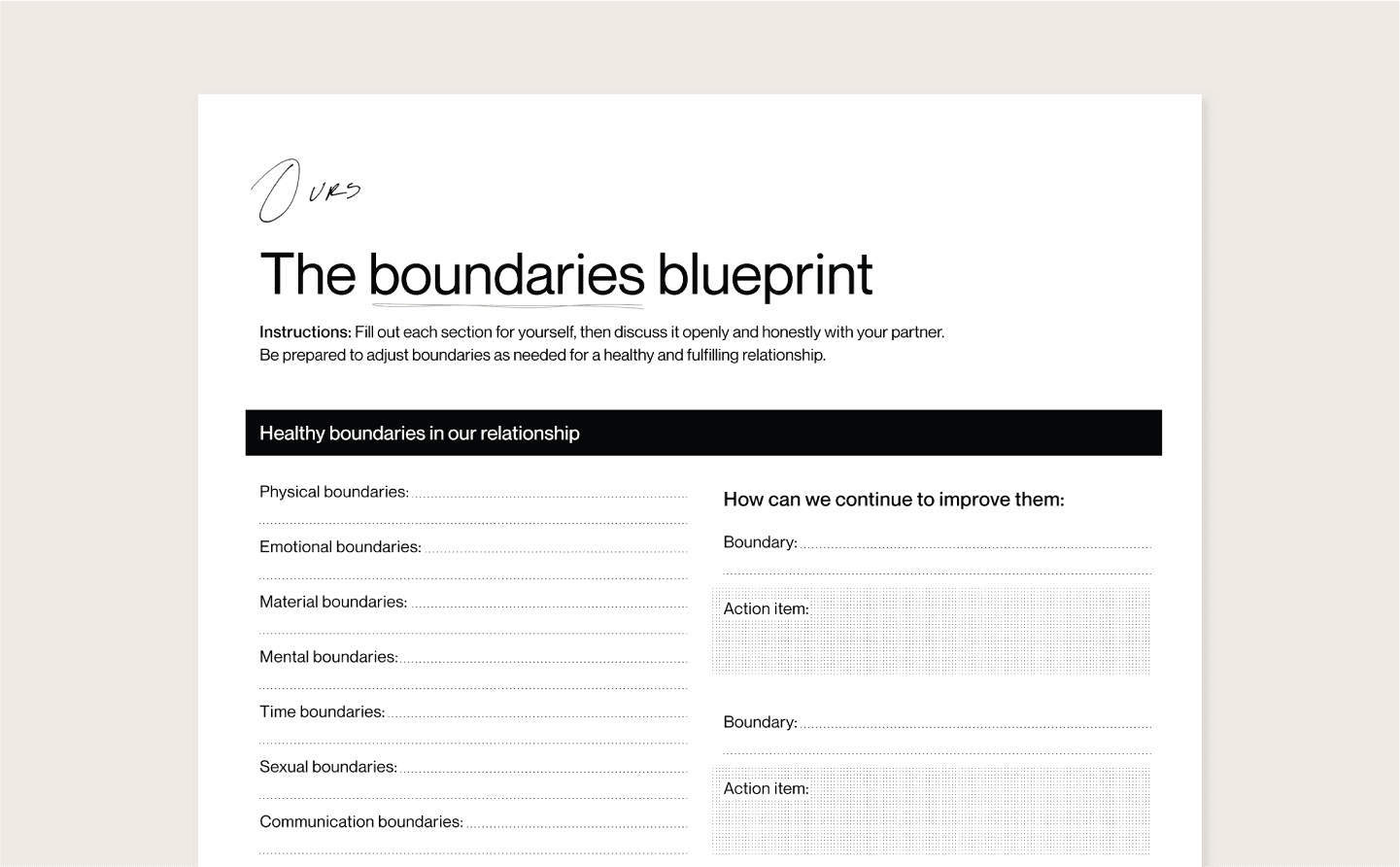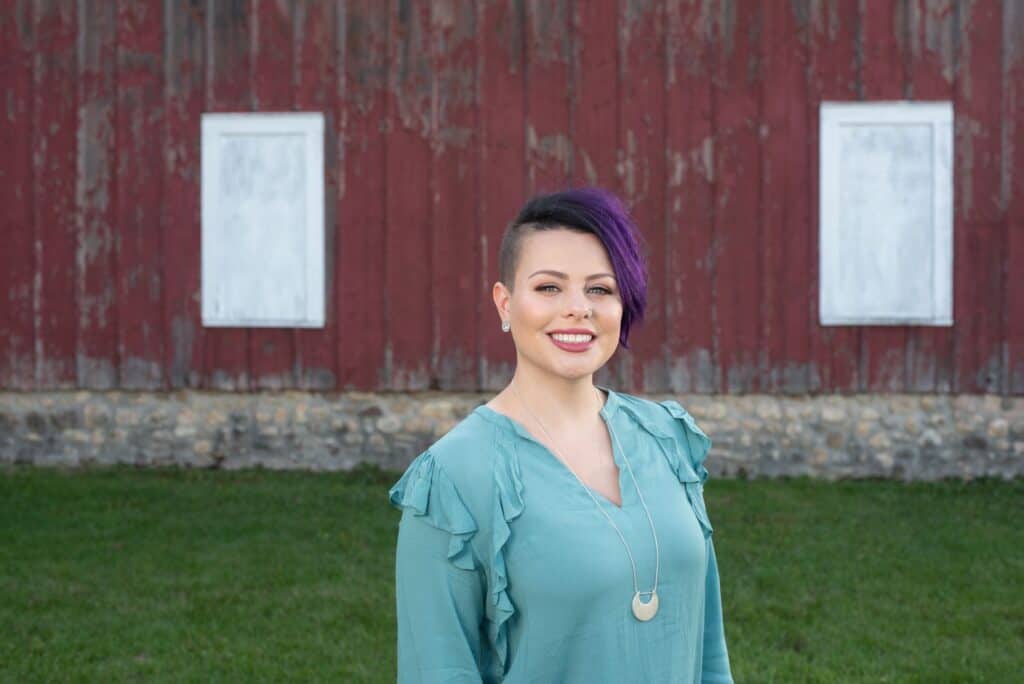Relationship wellness
How to set boundaries in a relationship: Balancing clarity with compassion

contents
Healthy boundaries and a strong sense of self are essential to maintaining a strong, stable relationship. But how do you build up boundaries without pushing your partner away?
Are you feeling drained? Boundaries might be the self-care superpower you’ve been missing.
Healthy boundaries are clear guidelines that define what interactions and behaviors are acceptable and unacceptable in your relationships. Boundaries can apply to any type of relationship, from platonic to romantic. They serve to protect your personal space, encourage respect, and value your emotions.
In fact, Benu Lahiry, Chief Clinical Officer at Ours says, “Honoring and communicating your current emotional state, even if not ready to fully embrace alternative perspectives, reflects emotional maturity and a secure relationship with oneself.”
In this guide, you’ll learn how to set boundaries in a relationship with confidence and what different boundaries can look like. Discover how healthy boundaries lead to stronger, more fulfilling connections.
1. Self-reflect on your boundaries
Before you discuss individual boundaries with your partner, take some time for self-reflection. Identify what’s important to you in areas of your relationship, like physical touch, finances, and privacy. Understanding your boundaries will make it easier to communicate them clearly and effectively.
It’s okay for boundaries to change as you grow as a person and your relationship evolves. When one of your boundaries shift (e.g., you no longer like public displays of affection), communicate openly with your partner. This ensures they understand your current needs and can continue to respect your boundaries.
2. Clearly communicate your boundaries
Open and honest communication is key when setting boundaries with your partner. By being clear and direct about your needs, you can avoid confusion and ensure your boundaries are respected in the future.
Use “I” statements rather than “you” statements to express your feelings. For example, opt for ‘I feel like I am not being heard’ instead of ‘You aren’t understanding what I’m saying.’
3. Listen to your partner’s boundaries and needs
Once you’ve expressed your feelings and boundaries, provide your partner the space to do the same. Practice active listening to understand their needs, asking questions until you fully understand their perspective.
You may learn you and your partner share common boundaries or have boundaries you weren’t aware of before. Both you and your partner deserve the same time and respect to explain and set your boundaries.
4. Enforce the boundaries
Maintaining and respecting boundaries is just as crucial as setting them. If your partner repeatedly disregards a specific boundary, be clear and firm about the consequences.
Open and honest communication is key — remind your partner of the boundary and explain how their actions make you feel. If the issue persists despite your efforts, it’s important to evaluate whether the relationship is meeting your needs.

5. Ask for space when needed
It’s perfectly normal to need short-term physical and emotional space, no matter how long you’ve been in this relationship. Whether you’ve had a tough day at work or a difficult conversation with your partner, communicating your need for some time to decompress is crucial. Explain how this space will benefit you, but also be open to hearing your partner’s feelings about it.
Choose a calm and neutral time to initiate a conversation about boundaries. Avoid times of stress, like right after work, to ensure a productive conversation.
6. Learn how to say “no”
Saying “no” is no easy feat, but it’s crucial for maintaining healthy boundaries. Practicing saying no to things that violate your boundaries can minimize stress on yourself and the relationship. Plus, it helps promote a more balanced life, protecting your energy and time.
7. Ask for feedback
After some time has passed to allow for processing, check in with your partner about the boundaries you discussed. Use open-ended questions like:
- Do you feel like our boundaries are clear and respected?
- Is there anything I can do to better support your boundaries?
This is a great opportunity to ensure your boundaries are understood and to address any unresolved concerns from either of you.
Boundaries 101: Different types explained
Different types of boundaries can coexist within a healthy relationship. Below, we’ll explain these boundaries and what they look like in their healthy forms.
Physical boundaries
These involve respecting your comfort level with physical touch and personal space. They can also encompass your physical needs, which may influence your preferred love languages in a relationship.
Example boundary: “I don’t feel comfortable with heavy PDA while we’re out in public.”
Emotional boundaries
These are for respecting each other’s emotions and feelings. They allow you to accept and communicate your emotions healthily while ensuring neither person’s feelings are invalidated. These boundaries can also encompass your limits for dealing with your partner’s emotions and knowing when you need emotional space.
Example boundary: “I need time to process my emotions before I can clearly communicate them to you.”
Material boundaries
These involve your comfort level with sharing personal possessions and managing finances with your partner. This includes openly communicating about your financial assets, spending habits, and what financial responsibility looks like in your relationship.
Example boundary: “I would prefer to split the cost of meals evenly when we eat out together until we’re ready to take the next step in our relationship.
Mental boundaries
Mental boundaries promote respecting each other’s thoughts, beliefs, and opinions. Even when you disagree with your partner on a topic, a healthy boundary involves respecting their viewpoint and hoping for the same respect in return. This allows for open and honest communication without feeling judged.
Example boundary: “While I don’t agree with you on this, I appreciate your willingness to consider my perspective as well.”
Time boundaries
These boundaries are to respect each other’s need for personal time and create a healthy balance between spending time together and pursuing individual interests.
These boundaries may change as your relationship progresses, especially with life events like moving in together or having children. Maintaining these boundaries ensures you have time for activities you enjoy outside the relationship.
Example boundary: “I have a basketball league game every Wednesday night. Can we make sure to keep those evenings free?”
Sexual boundaries
These involve your comfort level with physical intimacy and sexual interactions. This includes open and honest communication about your desires, needs, and what you’re comfortable with. It’s crucial to remember that “no” always means no, regardless of the situation.
Example boundary: “I’m not comfortable taking things further yet. Can we talk about what feels good for both of us?”
Communication boundaries
These are your preferred methods for communicating with your partner, including conflict management and difficult topics. This may include actively listening to each other, setting clear boundaries on certain issues, and expressing your needs. Ideally, communication should lead to compromise and understanding, even after challenging conversations.
Example boundary: “Can we make sure we don’t shut down conversations until we both feel heard and understood?”

What do unhealthy boundaries look like?
Now that we have examples of what healthy boundaries look like, it’s just as important to recognize what unhealthy boundaries are and how to fix them. Below are some common unhealthy boundaries that can occur in relationships.
1. Lack of any boundaries
The lack of existing boundaries can lead to many problems and manifest differently in various relationships. It may look like a constant need for 24/7 communication or unwanted physical content. It can also appear as a one-sided situation where one partner has established boundaries, but the other doesn’t feel comfortable establishing their own.
Establishing clear boundaries with your partner will allow you the space to pursue individual growth. Personal time can help foster a sense of independence and respect for each other’s needs.
Ask yourself: “Do I feel pressured to be constantly available to my partner, even when I need time for myself?”
2. Poor communication
Open and honest communication is key for both partners to express their feelings and avoid confusion. However, when there is a lack of healthy communication, this can hinder the relationship and impact your boundaries. Using communication exercises is a great way to practice with your partner so you can effectively convey your boundaries and needs.
Ask yourself: “Do I feel comfortable openly expressing my needs and feelings to my partner?”
3. Disregard for personal space
Similar to the lack of boundaries, the absence of personal space or time can easily occur in a relationship and has negative consequences. One partner may feel their partner constantly monopolizes their time.
They may struggle to find time for activities they enjoy independently. This lack of space can breed resentment. It’s important to have an open conversation about your need for independent time before it becomes the norm.
Ask yourself: “Do I feel like I never have enough time for myself or the things I enjoy outside of the relationship?”
4. Manipulation
Emotional dependence can develop in the absence of healthy boundaries, often involving manipulation, where your partner may use tactics like guilt-tripping or leveraging their emotions to control your reactions.
When individuals struggle to function independently, they may resort to manipulation to hold control over their environment, including you. When you recognize manipulation, it’s important to have an open conversation about how you feel and what you need to change.
Ask yourself: “Does my partner make me feel responsible for their happiness or well-being?”
5. Rigid boundaries
While clear boundaries are important for a healthy relationship, rigid boundaries can limit flexibility and communication. Feeling unheard due to your partner’s distancing can hinder building an intimate relationship. Practicing open communication and finding realistic compromises can allow for a better connection.
Ask yourself: “Does my partner ever express feeling distant or unheard because of my boundaries?”
Benefits of setting boundaries
Setting boundaries in a relationship is important for both protecting your well-being and respecting your partner’s expectations and needs. Below are a few of the many benefits of setting healthy boundaries.
1. Fosters self-respect
Respecting boundaries in a relationship is a win-win. It fosters self-respect and strengthens your connection with your partner. You feel less pressured to compromise your needs for your partner, leading to a better sense of self-worth.
2. Improves communication skills
Setting boundaries strengthens your communication skills by pushing you to express your needs and feelings clearly, promoting understanding and open communication with your partner. This ongoing honesty helps avoid misunderstandings and fosters a stronger connection between you.
3. Reduces stress
Constant conflict can lead to overwhelming stress on the relationship and yourself, which can trickle into other parts of your life, including work and friendships. Open and honest communication helps avoid misunderstandings about boundaries, thereby minimizing conflicts.
4. Protects emotional well-being
Healthy boundaries protecting your mental space contribute to your emotional well-being. When your emotions are balanced, you’ll feel more secure and content in your relationship, fostering ongoing growth for both partners.
4. Improves relationship
The mutual agreement to maintain boundaries builds trust in your partner, fosters closeness, and improves the overall quality of your romantic relationship. Boundaries are a work in progress, but setting aside time to continue working on your relationship is crucial for the long term.
Setting boundaries worksheet
Use his worksheet to outline your current boundaries with your partner — both healthy and unhealthy. Fill each section for yourself, and then discuss it openly with your partner.
Pair this activity with other therapy worksheets to foster a healthy conversation about your relationship.


Start your therapy journey with Ours
Learning how to set boundaries in a relationship is just one key part of supporting a balanced partnership. Visit the Ours sign-up page to explore how you can continue fostering a healthy relationship.









